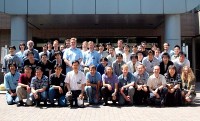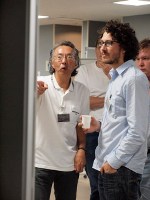 |
 |
|||||||||||||
|
|||||||||||||
|
|||||||||||||
|
Just a 15-minute walk from Matsumoto Castle in Nagano prefecture, which is considered a national treasure of Japan, you’ll find Shinshu University, where the International Conference on Photon Detectors, or PD09, was held from 24 to 26 June. The conference was attended by 55 photon-sensor experts in the field of high-energy physics, nuclear physics, cosmic-ray physics and medical science, along with three companies–Hamamatsu, SEIKO EG&G and General Electric–to discuss the recent development of photon-sensors and various applications. In 2007, both the ILC and the T2K neutrino experiment project groups initiated this bi-yearly conference in Kobe to collaborate on the use of the multi-pixel photon counter (MPPC) and other newly developed photon-sensors.
The total of 33 talks and six poster sessions presented at the three-day conference were dedicated to the so-called pixelated photon detectors (PPD) and photomultiplier tubes such as HAPD. PPDs attain large gain and photon detection efficiency through electron avalanches in the presence of an electric field, unlike photomultiplier tubes where signals from a single photon are multiplied as they bounce around inside a tube. This brings about the PPDs' compact size and low operation voltage, and their insensitivity to magnetic field conveniently suits high-energy particle physics experiments. The drawbacks are apparent in their temperature sensitivity and possible damages by radiation, where physicists are working to understand such behaviours as ‘dark counts’ produced by generation of free carriers, ‘after-pulses’ caused by carrier trapping due to a high-temperature plasma after a breakdown, and ‘cross-talks’ of optical signals among neighbouring cells.
The International Linear Collider's contributions have been mainly the results of studies for the scintillator electromagnetic calorimeter (SCECal) and the analog hadronic calorimeter (AHCal) which use MPPCs and SiPMs for the detection of scintillation light from organic scintillators. As a spin-off, the application of SiPM to positron emission tomography (PET) is studied. “Detectors for PET and calorimeters are quite similar, while a PET-detector would require much higher energy, spatial and timing resolution compared to a calorimeter,” says Alex Tadday of University of Heidelberg, who has been working on the characterisation studies of silicon photomultipliers for ILC's analog HCAL and PET (read how a calorimetry could save your life to learn more about his research). He presented results from studies of photon detection efficiency, cross talk, and after-pulsing of these sensors which will facilitate the selection of a sensor-type from the variety of devices available today. Often and increasingly, ILC benefits from such horizontal collaboration. “For me it was great to get into contact with people from T2K experiment,” assures Tadday, “because I was able to discuss my results with them in detail and also receive useful feedback which will help me in my future work.” He plans to improve his measurements by even more detailed studies of the cross-talk effect.
On the ECal side, Katsushige Kotera from Shinshu University and Yuji Sudo from the University of Tsukuba are investigating the feasibility of the scintillator ECal with 1600 pixel MPPCs for the ILD detector, one of three detector concepts for the ILC. “Through several beam tests, we think we have established a good ground for scintillator calorimetry strips that will match the ILD requirements,” says Kotera in his summary. For him, there is more brushing-up to do on the analysis using different parameters and on the optimisation of scintillator size and so forth while the group awaits a still greater number of pixels, but the progress is promising. In the summary talk, Yury Kudenko of the Institute for Nuclear Research in Moscow concluded by reviewing an impressive graph of MPPC shipment history made last year by Hamamatsu to T2K, the first physics experiment to use MPPCs. Two years ago, Hamamatsu was still in the R&D phase, and during its one-year shipment period from Febuary 2008 to February 2009, they had successfully shipped out 63,855 pieces without failure. “There have been excellent progresses in the characterisation studies of PPDs over the past two years,” says Kudenko, “and it is my personal point of view that the actual MPPC product is the most exciting achievement, an important progress in real applications in real experiment.” -- Misato Hayashida |
|||||||||||||
| © International Linear Collider |


